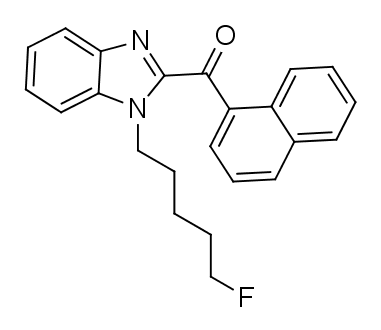Summary
FUBIMINA, also recognized under the aliases BIM-2201, BZ-2201, and FTHJ, is a synthetic cannabinoid, constituting the benzimidazole counterpart to AM-2201. This compound has gained prominence as an active ingredient within synthetic cannabis blends. Its initial discovery took place in Japan in 2013, concurrently with the identification of MEPIRAPIM.
FUBIMINA exerts its influence as a moderately potent agonist for the CB2 receptor (Ki = 23.45 nM), exhibiting a remarkable 12-fold selectivity over CB1 (Ki = 296.1 nM). Intriguingly, it does not completely mimic the effects of Δ9-THC in rat discrimination studies.
It is noteworthy that similar benzimidazole derivatives have been documented for their exceptional selectivity as agonists for the CB2 receptor, signifying the potential of this class of compounds in cannabinoid research.
| Identifiers | |
|---|---|
| IUPAC name | |
| CAS Number | 1984789-90-3 |
|---|---|
| PubChem CID | 124519316 |
| ChemSpider | 30646758 |
| UNII | U96GD9R3UZ |
| Chemical and physical data | |
| Formula | C23H21FN2O |
| Molar mass | 360.432 g·mol−1 |

fAQ
1. What is FUBIMINA?
- FUBIMINA, also known as BIM-2201, BZ-2201, and FTHJ, is a synthetic cannabinoid closely related to AM-2201 and has been used as an active ingredient in synthetic cannabis products.
2. Is FUBIMINA Legal?
- The legal status of FUBIMINA varies by location. It’s essential to check your local laws and regulations regarding its use and distribution.
3. How Does FUBIMINA Affect the CB1 and CB2 Receptors?
- FUBIMINA acts as a reasonably potent agonist for the CB2 receptor, with a notable selectivity over the CB1 receptor. It does not fully mimic the effects of Δ9-THC in certain studies, indicating unique properties.
4. What Are the Effects of FUBIMINA?
- The effects of FUBIMINA may include alterations in mood and perception. However, its specific effects can be unpredictable and potentially harmful, considering it is a synthetic cannabinoid.
5. Is FUBIMINA Safe to Use?
- The safety of FUBIMINA is a subject of concern due to limited research. The use of synthetic cannabinoids like FUBIMINA can be associated with significant risks to health and safety.
6. Can FUBIMINA Cause Addiction?
- Like many synthetic cannabinoids, FUBIMINA may have addictive potential when used irresponsibly or in excessive amounts.
7. Where Can I Find FUBIMINA?
- FUBIMINA may be available through illicit means or on the black market. However, it is crucial to emphasize that the use of synthetic cannabinoids for recreational purposes can be illegal and dangerous.
8. Are There Similar Compounds to FUBIMINA?
- Yes, FUBIMINA belongs to a class of synthetic cannabinoids with benzimidazole analogs. Some related derivatives have been reported to have high selectivity as agonists for the CB2 receptor.
9. How Should I Stay Informed About FUBIMINA?
- To stay informed about FUBIMINA, refer to reliable sources, scientific literature, and local authorities. Always prioritize your safety and adhere to the laws and regulations of your region regarding synthetic cannabinoids.
10. What Are the Potential Medical Applications of FUBIMINA?
- As of my knowledge, the cutoff date in January 2022, and FUBIMINA’s potential medical applications need to be well-established. Research in this area may have evolved, so consult up-to-date sources for the latest information.
References
- Explore the world of FUBIMINA at Cayman Chemical, offering valuable insights into this synthetic cannabinoid. (Retrieved on June 22, 2015)
- Xingxing Diao, Karl B. Scheidweiler, Ariane Wohlfarth, Mingshe Zhu, Shaokun Pang, Marilyn A. Huestis (2016). “Unraveling the Distinctive Metabolism of FUBIMINA (BIM-2201) in Human Hepatocytes to Differentiate It from Its Isomer THJ-2201.” Published in Forensic Toxicology, 34(2), 256–267. doi:10.1007/s11419-016-0312-2. PMC: 4971051. PMID: 27547265.
- Uchiyama N, Shimokawa Y, Matsuda S, Kawamura M, Kikura-Hanajiri R, Goda Y (2014). “Discovery of Two New Synthetic Cannabinoids: FUBIMINA and MEPIRAPIM.” Detailed in Forensic Toxicology, 32(1), 105–115. doi:10.1007/s11419-013-0217-2. S2CID 32599561.
- Jenny L Wiley, Julie A Marusich, Timothy W Lefever, Kateland R Antonazzo, Michael T Wallgren, Ricardo A Cortes, Purvi R Patel, Megan Grabenauer, Katherine N Moore, Brian F Thomas (June 2015). “Exploring the Affinity and Potency of Novel Synthetic Cannabinoids: AB-CHMINACA, AB-PINACA, and FUBIMINA, in Producing Δ9-Tetrahydrocannabinol-Like Effects in Mice.” Published in the Journal of Pharmacology and Experimental Therapeutics, 354(3), 328–39. doi:10.1124/jpet.115.225326. PMC: 4538877. PMID: 26105953.
- Daniel Pagé, Elise Balaux, Luc Boisvert, Ziping Liu, Claire Milburn, Maxime Tremblay, Zhongyong Wei, Simon Woo, Xuehong Luo, Yun-Xing Cheng, Hua Yang, Sanjay Srivastava, Fei Zhou, William Brown, Miroslaw Tomaszewski, Christopher Walpole, Leila Hodzic, Stéphane St-Onge, Claude Godbout, Dominic Salois, Keymal Payza (July 2008). “Unveiling Novel Benzimidazole Derivatives as Selective CB2 Agonists.” Presented in Bioorganic & Medicinal Chemistry Letters, 18(13), 3695–3700. doi:10.1016/j.bmcl.2008.05.073. PMID: 18522867.